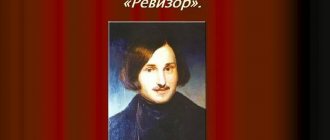Tickets (option 6) 14. Philosophical and social meaning of Balzac’s novel “Shagreen Skin”.
14. Philosophical and social meaning of Balzac’s novel “Shagreen Skin”.
Honore Balzac is the son of a notary who became rich during the Napoleonic wars. His novels became, as it were, the standard of realism of the first half of the 19th century. Writer of the bourgeoisie, master of a new life. That is why he turned away from V. Hugo’s statement that “reality in art is not reality in life,” and saw the task of his great work in showing not “imaginary facts,” but in showing what “happens everywhere.” “Everywhere” now is the triumph of capitalism, the self-affirmation of bourgeois society. Showing an established bourgeois society - this is the main task set by history for literature - and B. solves it in his novels.
The idea of a unified system of works arose in Balzac in 1833, when he realized that his desire to give a broad panorama of life in France, which led to the emergence of side plot lines, could not be realized in one novel. This is how the “Human Comedy” began to take shape with its characters moving from novel to novel, of which, according to the author’s own plan, there should have been at least 2-3 thousand. The author arranged the novels of The Human Comedy into the following sections: 1) etudes of morals, which included scenes of private, provincial, Parisian, political, and rural life; 2) philosophical studies; 3) analytical studies.
The clearest example of philosophical stories is “Shagreen Skin,” which the author called “the formula of our present century, our life, our egoism,” he wrote that everything in it is “myth and symbol.” The French word Le chagrin itself can be translated as “shagreen,” but it has a homonym almost known to Balzac: Le chagrin – “sadness, grief.” And this is important: the fantastic, all-powerful shagreen skin, having given the hero relief from poverty, was in fact the cause of even greater grief. It destroyed the desire to enjoy life, a person’s feelings, leaving him only selfishness, generated to prolong his life slipping through his fingers as long as possible, and, finally, its owner himself. That is why Balzac forced the rich banker Taillefer, having committed a murder, to be one of the first to greet Raphael de Valentin with the words: “You are ours. “The French are equal before the law” is now for him the lie with which the charter begins. He will not obey the laws, but the laws will obey him.” These words truly contain the formula for life in 19th century France. Depicting the rebirth of Raphael de Valentin after receiving millions, Balzac, using the conventions acceptable in the philosophical genre, creates an almost fantastic picture of the existence of a man who became a servant among wealth that has turned into an automaton. The combination of philosophical fiction and the depiction of reality in the forms of life itself constitutes the artistic specificity of the story. Connecting the life of his hero with the fantastic shagreen skin, Balzac, for example, describes with medical precision the physical suffering of Raphael, suffering from tuberculosis. In “Shagreen Skin,” Balzac presents a fantastic incident as the quintessence of the laws of his time and, with its help, discovers the main social engine of society - monetary interest, which destroys personality. This goal is also served by the antithesis of two female images - Polina, who was the embodiment of the feeling of kindness, selfless love, and Theodora, in whose image the soullessness, narcissism, vanity and deadening boredom inherent in society are emphasized.
One of the most important figures in the story is the image of an antiquarian, whose judgments reflect Balzac’s thoughts that human life can well be defined by the verbs “to desire”, “to be able” and “to know”. “To desire burns us,” he says, “and to be able destroys us, but to know gives our weak body the opportunity to forever remain in a calm state.” All ambitious people, scientists and poets - Rastignac, Sechar and Valentin - are in a state of “wishing”. The state of “being able” is achieved only by those who know how to adapt to a society where everything is bought and sold. Only Rastignac himself becomes a minister and marries the heiress of millions. Raphael receives shagreen, which works no worse than the convict Vautrin. Those in the state of “knowing” are those who, despising the suffering of others, managed to acquire millions - these are the antiquarian himself and Gobsek. However, in reality, they too turned into servants of their treasures, into people like automata (the antique dealer is 102 years old!). If, like Nucingen, they suddenly find themselves obsessed with desires not related to the accumulation of money (the passion for the courtesan Esther), then they themselves become figures, both sinister and comic, because they step out of their social role.
Analysis of the novel “Shagreen Skin” by Honoré de Balzac
author: Ekaterina 11/10/2020 8 Comments
articles
In this article we will analyze Balzac's novel "Shagreen Skin". In the format of an essay-reasoning.
My favorite movement in literature is critical realism. This movement of the 19th century has a holistic worldview and a certain attitude towards reality. Realism of the 19th century reveals all the details of the social structure and examines all types of human relations. The realist writer deeply studies the inner world of man, his vices and desires, social inequality, etc.
My favorite work is “Shagreen Skin” by Honore de Balzac. This is an encyclopedia of the young, ambitious, but poor youth of France. Raphael de Valentin is the main character, a representative of this youth. He is surrounded by poverty and hunger. The problem of career also arises in the work. Despite the enormous work of the main character, the dream of becoming an outstanding journalist does not come true; he feels useless and unrecognized in society. The main reason for the failures of young Raphael is a conflict with his time.
Despite the fact that the novel belongs to the genre of realism, it also contains fantastic and mystical elements. These include the amulet he found - shagreen leather, which fulfills wishes, but at the same time shortens the life of the owner.
I liked this book because the author broadly covers many issues and reflects the spirit of that time. The main problem of young people is greed and vanity. Excessive wastefulness does not lead to anything good. This can be clearly seen by observing the events of the novel. I think that if Raphael had stopped in time and had not wasted his shagreen skin on empty desires, then the life of the protagonist could have been saved. The author reflected the whole essence of people: when a person finds himself between life and death, it is at this moment that he realizes all the value and charm of life.
Also, analyzing the plot of the book, I draw parallels between Mephistopheles and “Shagreen Skin”, between “Poor Lisa” and the charming Polina. Polina is the main character, Raphael's lover. This is a sincere, kind and sympathetic girl who loved and supported the main character throughout the entire work. Raphael blindly loved the “woman without a heart” who did not know what sacrifices the protagonist made for her. Only when Raphael is disappointed and left alone does he understand what he had not seen before. After a long time, Rafael finally notices Polina, her beauty, external and internal. After which he falls in love and seems to come to life again.
This piece made me care about Raphael and Polina, hoping for a chance at redemption and the potential happiness of the main character. But the work ends with the death of the lovers.
Tension, hopelessness, loneliness, suicidal thoughts, disappointment, uselessness, poverty, hunger, pain permeate Balzac's work. In the modern world, these problems also occur among adolescents and older people, so they are still relevant.
From personal observation, I can give an example: I know a talented girl who has excellent scores in school subjects and creative abilities. She dreams of entering the Stieglitz Academy, but due to the past crisis and the reduction of budget places, she cannot enter the desired specialty at the most ordinary institute. Life forces you to do and do things that a person does not want due to poor financial situation. The problem of loneliness and misunderstanding is even more common. This work made me realize how important it is to help and support people, as well as how important it is to value your life, because it is not material things that make it happy.
Essay provided by Alexandra usan-2016.
Similar articles:
My favorite work is Bulgakov’s novel “The Master and Margarita” (essay-reasoning)
Essay “The role of books in human life”
Don’t be greedy, share on social networks if the article was useful:
← Previous post
Next entry →
“Shagreen Skin” by Balzac – a parable or a portrait of time and society?
Honore de Balzac conceived and almost brought to life a daring plan: to write a series of novellas and short stories in which a literary model of contemporary France would be created. He called the main creation of his life “The Human Comedy”, by analogy with Dante Alighieri’s “The Divine Comedy”. The writer hoped that it would become as significant for the 19th century as the creation of the great Florentine for the Middle Ages. The anthology was supposed to contain 144 works, connected by transitional characters, a single style and issues. However, Balzac managed to write only 96 of them. “Shagreen Skin” (1831) is also included in this cycle and is located in the “Philosophical Studies” section.
This novel examines the conflict between the individual and society, which was the focus of contemporary literature (for example, Stendhal's The Red and the Black). However, the book's philosophy and multiple meanings make it feel like a parable with deep meaning. “Shagreen Skin”, the summary of which boils down to a truly Buddhist conclusion that desires kill, nevertheless carries a life-affirming message: happiness is possible without a “magic wand”; it can be found in selfless love and the desire to give, and not take and own.
The main character of the work is Raphael de Valentin, an impoverished educated aristocrat. For several years he ekes out a poor man's existence in the attic of a small hotel, unaware that the owner's daughter, Polina, is in love with him. He himself became infatuated with the brilliant socialite Countess Theodora, and for her sake he began to play in the casino, spend madly on gifts, after which there was only one way out for his honor - suicide. This is how the novel “Shagreen Skin” begins.
Lacking better ideas, the hero goes into an antique shop, where he purchases a piece of donkey skin, on the back of which is embossed in some oriental language the inscription: “When you take possession of me, I will take possession of you. I will fulfill your wishes, but with each of them I will decrease - just like your life. Therefore, balance your desires.” Not believing in the effectiveness of what was written, Rafael plans a revelry, and immediately meets his friends who invite him to have a drink. He traces the contours of his talisman in ink and makes a wish to receive great wealth. The next morning, the solicitor informs him that his uncle died in India and bequeathed all his considerable savings to the young de Valentin. Raphael reaches into his pocket and takes out the antique dealer's gift. The shagreen skin has shrunk in size!
The subsequent narrative unfolds rapidly: having believed in the effectiveness of the talisman, Raphael tries to give up his desires. But an accidentally dropped polite phrase “I wish you happiness,” attraction to the woman he loves and the thirst to win a duel quickly wipe out his days.
Shagreen skin decreases in size; no physical experiments can stop this process. In the end, the hero dies in his luxurious home in the arms of Polina, who loves him without any miracles or talismans.
It seems that the entire work is a parable about soul-burning desires, symbolized by shagreen skin. An analysis of the style of the novel nevertheless shows that Balzac works in a narrative style and builds on the romanticism of his predecessors, writers of the early 19th century, using very realistic details coupled with a colorful and dynamic composition. The hero describes the history of the ruin of his family in such a way that anyone who knows the economic and political realities of France at the end of the reign of Louis XVI will not doubt the veracity of his words. The sincerity of this novel, despite the fantastic plot, places it among the best works of classical realism.




